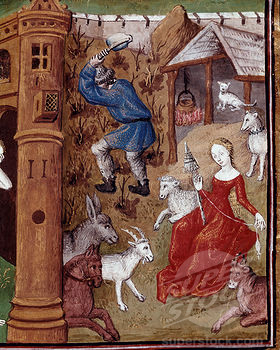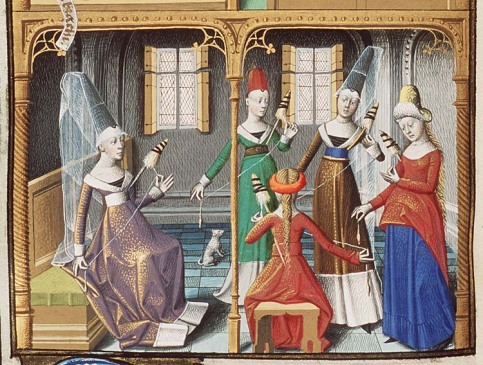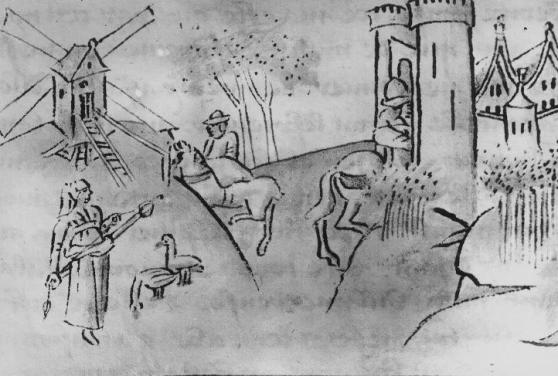So, I’ve come to the decision to start what I’ve wanted to start for a while. Spinning. 1480 style. How am I going to learn this? Well, I’ll combine a little experimental archaeology with pictorial research and reference to more modern peoples who spin in a similar style.
Why all this effort? Drop spinning is undergoing a bit of a revival (especially in America) and there are countless tutorials on how to do it.
Well, take a look at a modern person drop spinning and you’ll notice a few things. The spindle is usually dropped in front of the spinner and as it drops and spins more fibre is drafted to be turned into thread. A good modern drop spindle is perfectly balanced and often has a whorl weighted on the outer rim so it can spin a long, slow spin. This long and slow spin is perfect for spinning with a drop spindle.
Now, take a look at some paintings of medieval folks using a spindle to spin.
Many people look at pictures such as these and notice that none of the spinners are actually spinning. Some surmise that this was because they were painted winding the thread onto the spindle. There are images that depict this action so other surmise that they are simply holding the spindle and thread out gracefully. I have seen it suggested that they are actually spinning in these pictures but I have just as often seen this scoffed at by spinners as you “can’t” spin in this position. But take a look at this picture.
You can see here that the spindle has left the spinner’s hands, suggesting that she’s not just holding the spindle out to wind the thread on. The other explanation I’ve seen to explain why the spinners are painted like this is because it was simply an artistic convention and that nobody really span like that. This is possible, there were many artistic conventions at the time, but what is the proof that this was an artistic convention? The proof is that you “cant” spin like that, therefore they didn’t. They didn’t spin like that, so you can tell that it is an artistic convention. How do we know they didn’t spin like that? Because it’s an artistic convention. How do we know this? Because they didn’t spin like that. You can see where this argument is going and it’s going in circles.
First, lets start with the only external evidence—that people can’t spin like that. I have seen photos from Portugal,Russia, Romania and other countries of women from the 18th, 19th and 20th century all spinning in a similar manner. You could argue that these woman were all just posing and copying the pose they had found in medieval pictures but that is getting a little far-fetched. Furthermore I’ve seen videos of woman from these countries actually spinning and their hand positions are very similar. Take a look.
So can you spin like that? Yes.
Did they in the 15th century? Well, it could still be an artistic convention, but if so then why did every artist paint something he saw being done every day in a way in which he had never seen it before?
And why did painters continue painting women spinning this way through the 16th, 17th 18th and 19th centuries and why when the camera came about did photographers pose their subjects in this position to imitate not what they were doing but medieval art. And then what, when video came around women suddenly started trying to spin in the way they’d been pictured? You know what, it’s possible. We have no written descriptions of how to spin in the 15th century so who knows. To me, however, it isn’t likely. Not at all. For me the proof for the 15th century ladies spinning how they were pictured far outweighs any proof that it was just artistic convention.
So if we’re happy with the conclusion based on this research we’ll move onto some experimental archaeology, where applying practical skills and cross referencing these with the material culture from the archaeological record will yield yet more proof that women could have spun this way and did (at least some of the time).















Very interesting post. I’ve just started spinning (love it!) and am amazed when I watch videos of women (and men) spinning so seemingly effortlessly.
Thank you! I’m enjoying my early efforts at spinning also. Yes, they make it look so effortless! I suppose if I’d been spinning all my life it woud look effortless too!
what a great resource you have created here!
I only just saw your post! Thank you very much for your kind words
This is wonderful. I volunteer at a house in mid Wales where we try to recreate life during the late C15th and I am a spinner. I’m off now to analyse how I spin in the light of your comments!
Thank you Natasha! It sounds wonderful to me to have a house to volunteer at! We just have our tents pitched on a big field complete with gumtrees here!
Right now I’m still experementing especially with when/if the spindle actually gets suspended. What do you spin? Wool or flax or both?
Usually wool, but I’m hopng to graduate to flax this year. Here’s a link to where I volunteer: https://15thcenturyspinning.wordpress.com/2012/06/16/how-did-women-spin-in-the-15th-century/#comments As you say, we’re very lucky!
Having studied those pictures (and others) they seem to have very small whorls, where the whorl is visible. In others the whorl is not visible: either they are using continental spindles which have no whorl but where the shaft thickens towards the base or there is no whorl at all. I will be experimenting this year to try to work all this out!
Or where the shaft thickens towards the middle region significantly (ie, enough to act as a whorl). Or a combination that was probably partially dependant on place, time and/or what they were spinning (not just the fibre, but the weight.)
My spindle whorls are small (about 1 inch diameter) and I can slip them onto the end of my spindle. When I’m spinning really fine stuff I slip the whorl off once I’ve got enough of a cop on my spindle that I don’t need a whorl.
I look forward to hearing about your experements!
Thanks for this! I’m beginning to understand your research.
You’re welcome! I’m glad you’ve found this useful.
What a joy to have found this – thank you! The technique does look like a long draw. I have found on camp it is much easier to spin to the side predrafting as I go (I am not a natural at drafting from the fibre stack) and never thought about it until now as when we are at an event we can’t take pictures I have never realised that’s what I am doing. Partly I thing it must happen because if I am sitting down on a low box it gives me an extra length to work and means I can still be up right in my posture rather than leaning forward to clear my skirts from stopping the spindle from spinning. I also use a distaff coming from my back over my shoulder all of which gives me extra length to spin. I have noticed I spin from combed wool and most of my friends seem to spin from carded which means they have much smaller fibre bundles held in the hand which seems to make the whole action more contained and linear – meaning they spin from the hand straight down and always stand.
Thank you! I’m glad you’re enjoying my blog. Pictures at events are always tricky, even if your group allows it. I’ts really interesting hearing about all the other styles, both modern and ancient that are similar to the styles I’ve developed!
Hm, I stumbled on your site yesterday and lay awake for a long time puzzling over what you said. I know, major nerd here! But here’s the thing — if you twist the spindle in your hands rather than suspending it, you end up with some problems. First, you can’t get very much twist, compared to what you could get if you suspended it. (I’m a little confused — is ALL of the spin just twisting with fingers, or are they flicking it a bit to pick up a little spin as it slides through their fingers?) Either way, it’s not as much spin as you’d get suspended. And second, if you are dedicating one hand to twisting, you only have one hand for drafting. Both of those things would result in a weaker, fluffier woolen-style thread … when I thought they wanted strong, thin, worsted thread for weaving! I’ve read elsewhere that great wheels, when they were invented, were considered inferior for producing weaving thread because they didn’t produce enough spin and because you could only use one hand for drafting …. both issues you’d get with twisting a spindle in your hand!
Well, puzzling it out, I’ve come up with a couple answers. First, I notice most of these pictures are with flax, not wool — could it be that flax doesn’t need as much twist? Could the distaff help manage the fiber so you don’t need both hands? Is it possible that they suspended the spindle with wool, and held it in the fingers for flax? Perhaps these women are high-class ladies who are making knitting yarn or weft yarn rather than warp thread? All I know is that if you tried to make warp yarn for weaving, it would be prohibitively slow to do it that way … you would really, really be tempted to suspend the thing to get more twist and use your other hand.
As far as the small whorls go, if you are good at drop spindling and are making a fine yarn, a small heavy whorl (the ones we have from the medieval period are stone or lead) would be just fine. People who want lighter rim-weighted whorls are either making thicker thread, or just learning. A small whorl is great for a FAST spin … meaning you are very quick at drafting and are making thin yarn.
I also investigated ancient pictures — Egyptian and Greek — and they are all spinning suspended. So it’s not like suspended is new. It’s more like the finger-twisting method was popular in the High Middle Ages for some specific reason — a new purpose they wanted their yarn for, perhaps.
For the record, I spin suspended and am kind of addicted to watching the thing go around on its thread … so I admit I am partial!
I spent more time browing your blog and now I’m a bit embarrassed — you answered most of my questions elsewhere, so I see I should have read more before commenting. I see in your videos that you are flicking it and not just twisting it with your fingers, so it must be picking up more twist than I imagined. (The video with the Portuguese spindle above doesn’t show flicking, only twisting, so it doesn’t seem she’s getting much twist in there, but your method I see is a little different.)
I guess my only remaining question is why? Why quit spinning suspended and start holding the spindle in your fingers? Was it a cultural thing — northern European tribes already were spinning this method and the Roman occupation didn’t change their habits? Or was there some specific advantage? I still think you’d spin the same speed or slower by your method, and it seems awfully tiring on the fingers of the twisting hand. Another advantage to drop spindling is that you can leave the spindle spinning while you take a pot off the stove, feed the chickens, whatever. (I put my toddler to sleep in a back wrap while spinning, he’s utterly hypnotized.) Seems better for multitasking because although you use both hands, you don’t have to use both at every moment — you can take one off.
Is it just that a woman stuck her distaff under her arm one day to get something done and suddenly thought, “Heck, why take it out of there? I can just keep one hand on my spindle this way and only need one to draft!”
Makes me want to research spindles of various eras and cultures. There aren’t enough pictures of each period, but it seems to me if you find a tiny, heavy whorl, that would be one that might be used for your method.
Do you know what the earliest example is of your method? How long ago can we say for sure people were spinning like that?
Thank you for your comments! Don’t feel embarrassed, this was an early post and I’e asked myself many of the same questions through my research. Asking questions and wondering about things show you are actually thinking about what you are reading. I much prefer for people to read what I’ve written and do their own research than say “well, this is how she does it, it must be right!” My main goals for this blog are twofold, firstly to share my research with others, but also to encourage people to do their own. When I started my research the conventional wisdom available to me was “google how to spin on a drop spindle, do that. No, you don’t need a distaff for wool.”
I find with methods similar to what I think we’re seeing in the medieval images the handling of the spindle varies greatly. In that one hand is always at the distaff and one at the spindle, but some twist the spindle, some flick it, some suspend it (while keeping their hand nearby). My current thoughts is that this method isn’t defined so much by the use of the spindle, but the use of the DISTAFF.
I came to this conclusion when someone on a forum said “a distaff is just a place to store unspun fibre. It’s not involved in the spinning”. I responded by saying “then a spindle is just a place to store spun thread.”
Depending on the thread you’re spinning (not just the fibre, that too but also the thickness and twist you want) you might handle the spindle in different ways. The distaff is always needed and pretty much used the same way (as the hand tohold your fibre for you, allowing you to have one hand constantly at or near the spindle.
Your only remaining question is one we may not be able to answer. Yes, in ancient times they did spin differently. Not so much because it was suspended (I see a lot of suspended spinning in the 15th century images) but because of the distaff. The distaff is hand held, meaning it doesn’t to much more than hold fibre. It means you have to use one hand to spind the spindle AND draft, which means the spindle hangs verticle rather than being held out to the side. Who knows why they stopped. Quite possibly by the 15th century people din’t really know that people used to (or still did in places!) spin like that. Spinning wasn’t something they learnt looking at pictures or vases– they would have learnt at their mother’s knees as small children. I’m sure there were small regional variations, maybe the woman next door flicked her spindle differently? I don’t know they would have the resources or knowledge we do about different spinning styles to research which was the most productive. Also think that when a more productive method of spinning came along in the form of the spinning wheel there was a lot of resistance. Warp thread by law stil had to be spindle spun. There was a big focus on quality, those threads had to be woven into cloth that would last the user’s lifetime and be passed on in a will to their descendants. My modern clothes wear out after a few seasons!
While spinning was a constant task and I’m sure they wouldn’t have used methods that were slow for no good reason, I don’t think hey would have sacrificed quality and this method gives you very good quality control.
I find I can multi task with this method, either when (if) the spindle is being suspended you can use your spindle hand, or you can hold your spindle and use your distaff hand, or you can stick your spindle in your distaff or under your arm and use both hands.
So in short, why is very hard to answer, but the evidence strongly points to a method consistant with the spinning tradition that continued around Europe rather than that found in South America and spread to the western world via the 20th century craft revival.
What we can say for sure is why in some parts of Europe people STOPED spinning like this, and that’s the industrial revolution. It squished out a lot of old ways of doing things and in many parts of the orld when people wanted to revive the old crafts there was no-one left around that remembered them. So they learnt the methods from cultures who still had them.
I’d be very interested in any research you did into spindles of various cultures!
I actually don’t know the earliest example of this method (or this family of methods?) I haven’t done much research into the devolpment of these spinning styles, more into how they can be traced back through more modern styles. Someone else asked a similar thing recently so it is an avenue that I wish to research at some time.
But thank you for your comments! I always appreciate tha my research makes people think and I love comments that make me think as yours have done.
Neat blog! I’ve been spinning for years now, and always bring the spindle to my right. Why? It brings it closer to view, but most importantly you can spin longer before winding on because the thread stretches first across your body, then at an angle to the ground. You can get about twice the length of thread, so why let it hang straight to the ground?
Thanks! I’ve noticed in a few cultures across a few different spinning styles that people often bring their spindle to the right, in many cases probably for the reason you mention.
I’ve been discussing your blog about how the spindle is held with my sister (also a spinner). She has suggested 2 things: (1) the French still use spindles that they hold in their hand to turn and many of the paintings will be French in origin; certainly any high class lady seen spinning is likely to be French-descendant (Norman) even in England. (2) the way you spin when you hold the spindle is “off the tip” which seems to segue smoothly into the way you spin on a Great Wheel
I don’t read all the comment but Yes we can.
I ask myself the same questions when I began to spin, I don’t understand why this position… just for the photo?
Then I see a vidéo and I understand, and I try… And with this way (I call it 3 hands : one is the distaf) There is no pain! You can weave as long as you want with no pain.
And then I spin for two month everyday, every single minute I don’t work, I spin also with my friends, and walking (yes with this way walking and spinning fine is possible because your spindle don’t balance) and in the doctor room, with no pain. As befor I had pain 15mn after begining in my hand and my shoulders.
And so I could make a lot of thread as long for weave it and make a hood.